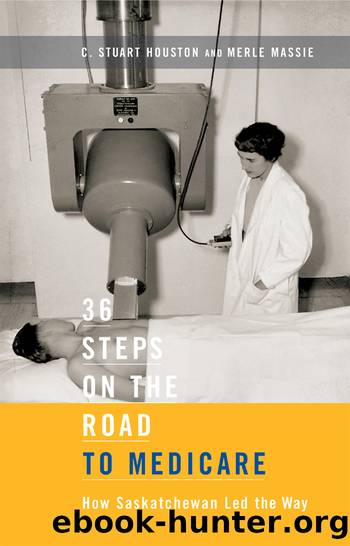36 Steps on the Road to Medicare by Houston C. Stuart;Massie Merle; & Merle Massie

Author:Houston, C. Stuart;Massie, Merle; & Merle Massie
Language: eng
Format: epub
Publisher: McGill-Queen's University Press
Published: 2013-10-31T00:00:00+00:00
CHAPTER 8
PROVINCEWIDE HOSPITALIZATION
Hospital services are costly. They require support from municipal and provincial governments to provide funding and sound policies. Above all, the primary concern should be for the patient. With momentum gained from experience with cottage and union hospitals and the Swift Current Health Region No. I, Saskatchewan moved toward provincewide hospitalization.
22. The first province to provide capital grants for widespread hospital construction, 1945
Saskatchewan took Sigeristâs advice to heart in becoming the first province to provide funds for capital construction of hospitals, a major step on the road to medicare.1 Between 16 March 1945 and 1 March 1949, the government provided $653,714 in outright construction grants and $173,500 in loans.2 The National Health Grants Programme in 1948 added substantial federal funds to support hospital construction; Saskatchewan, sadly, having been too quick off the mark, was ineligible for matching federal funds for new construction since most of its hospitals had already been built. The province was in double jeopardy because some of the operational health programs had also been launched in anticipation of federal support; it was learned only too late that, because they were already underway, they were disqualified from receiving federal assistance.3 Nonetheless, the Saskatchewan program moved hospital construction costs out of tight municipal budgets, allowing larger, better equipped hospitals to be built. Larger centralized hospitals could incorporate modern conveniences and technologies, from plumbing and heating infrastructure to power, which led to specialized laboratory and x-ray rooms. Twenty-one new hospitals were established over four years, and forty-one union hospital districts formed.4
23. The first universal hospitalization insurance program in North America, 1 January 1947
Introduction of the first provincewide, compulsory hospitalization insurance program in North America was achieved in Saskatchewan with remarkable speed and efficiency. Hospitalization was expected to cost even more than physician services and thus be the more expensive âhalfâ of the medicare equation.
Sigerist estimated that universal, provincewide hospitalization insurance would cost $3.60 per person (about $3.5 million)5 per year and would require another 1,000 to 1,500 hospital beds in Saskatchewan,6 including a university hospital of at least 500 beds.7 The first steps toward provincewide hospitalization insurance included: the Saskatchewan Social Assistance Plan (1 January 1945; see chapter 5), which paid for both medical and hospital services for the provinceâs most needy; free hospitalization and treatment for cancer patients; and full coverage for hospitalization and treatment for mental illness.8 The move to provincewide hospitalization insurance would spread the cost of hospital care across all citizens and ease financial pressure on smaller municipalities. It would also be least likely to disrupt the balance between the doctorsâ professional considerations and provincial or regional purse strings.9 The doctors in Saskatchewan enthusiastically and almost unanimously supported the introduction of provincewide hospitalization insurance on 1 January 1947. Doctors could now admit patients to hospital whenever necessary, without concern for cost. Patients could be treated in whichever hospital was best for their care, for the time needed to recover, whether that was a few days or many months. Small hospitals rejoiced, for a time.
Download
This site does not store any files on its server. We only index and link to content provided by other sites. Please contact the content providers to delete copyright contents if any and email us, we'll remove relevant links or contents immediately.
Application of a Novel Technique for Clinical Evaluation of Nitric Oxide-Induced Free Radical Reactions in ICU Patients by Unknown(693)
Rosenâs Emergency Medicine Concepts and Clinical Practice by Ron Walls; Robert Hockberger; Marianne Gausche-Hill; Timothy B. Erickson; Susan R. Wilcox(571)
Oxidative damage to surfactant protein D in pulmonary diseases by Vitality Starosta1 & Matthias Griese1†(406)
Social Science Perspectives on Global Public Health by Vincent La Placa & Julia Morgan(372)
Constructing Canine Consent; Conceptualising and Adopting a Consent-focused Relationship with Dogs by ERIN JONES(329)
Organic Chemistry: An Acid - Base Approach by MICHAEL SMITH(299)
ADVANCED EMERGENCY CARE AND TRANSPORTATION OF THE SICK AND INJURED by Unknown(270)
Saunders Nursing Drug Handbook 2024 - E-Book by Unknown(262)
Davis's Comprehensive Manual of Laboratory and Diagnostic Tests with Nursing Implications by Unknown(245)
Diagnostic and Statistical Manual of Mental Disorders, Fifth Edition, Text Revision (DSM-5-TR(tm)) by Unknown(245)
Socio-Life Science and the COVID-19 Outbreak : Public Health and Public Policy by Makoto Yano; Fumihiko Matsuda; Anavaj Sakuntabhai; Shigeru Hirota(244)
Human Microanatomy; Cell Tissue and Organ Histology with Celebrity Medical Histories by Stephen A. Stricker(242)
Berne and Levy Physiology E-Book by Unknown(234)
Replacing the Dead by Mie Nakachi;(229)
Handbook of Skin Disease Management by Jiyad Zainab;Flohr Carsten; & Carsten Flohr(228)
Access to Medicines and Vaccines in the South : Coherence of Rules and Policies Applied by the European Union Commission by Stephen Kingah(224)
The Pocket Guide to Sensorimotor Psychotherapy in Context (Norton Series on Interpersonal Neurobiology) by Pat Ogden(218)
Deep Learning and Medical Applications by Unknown(217)
Advances and Technical Standards in Neurosurgery by Unknown(213)
